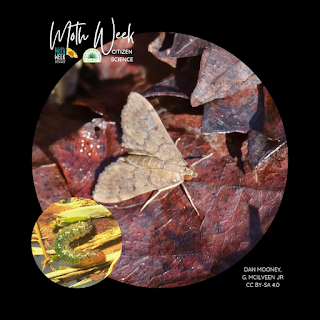National Moth Week 2023 - The Tropical Sod Webworm Moth
The tropical sod webworm moth or dark sod webworm (Herpetogramma phaeopteralis) is a small moth in the Crambidae family with a wingspan of about 10-12 millimeters. It is found in the Americas, from the southern United States to Argentina. The larvae feed on a variety of grasses, and are common sight in lawnscapes.
Sod webworms have a bivoltine life cycle (two generations in a year) with four stages: egg, larva, pupa and imago (adult). They overwinter as larvae in their final or penultimate instar in the lawn thatch or soil. With the coming of warmer weather, the larvae will pupate, and moths will appear in late spring or early summer. Females deposit eggs on grass blades in the evening, and eggs hatch in 3 to 4 days. Tropical sod webworms develop through six larval instars, pre-pupal and pupal stages over 21 to 47 days, depending on temperature. Multiple generations may occur during a year, especially in south Florida where adults can be found year round.
Larvae are cream-colored with brown spots on each segment and a dark, yellowish brown head. Mature caterpillars are ¾ to 1 inch long and grayish-green. The more grass they eat, the greener the caterpillars appear- simply because their abdomens are filled with leaf matter.
In large monocultures of St. Augustinegrass, Bermudagrass and Centipedegrass, these moths thrive and cause infestations. Over fertilization of lawns is a leading cause of population explosions. Numerous low-flying moths hovering above the lawn can be an indication of an outbreak. Lawn reduction along with encouraging natural predators such as spiders, lady beetles, big-eyed bugs, syrphid flies, ground beetles, rove beetles, parasitoid wasps, and the application of BT (Bacillus thuringiensis) at dusk as a biological pesticide can be used to control populations of the dark sod webworm moth, but there’s a paucity of documented impact.
Come celebrate moth awareness week collaboratively with National Moth Week and Florida Native Plant Society Like and share your own experiences with us.
Caterpillar image courtesy of Texas A&M University, G. McIlveen, Jr.
Adult image courtesy of Dan Mooney
Caption provided by FNPS President, Mark Kateli
Instagram: @markkateli | Facebook: Mark Kateli
#mothweek #fnps #herpetogrammaphaeopteralis




Comments